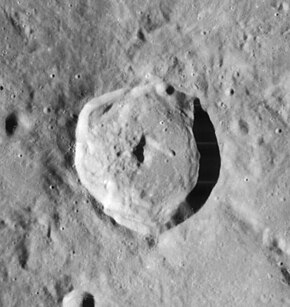Agrippa is a lunar impact crater that is located at the southeast edge of the Mare Vaporum. It is located to the north of the crater Godin, the irregular Tempel lies just to the east. To the north and northeast, the rille designated Rima Ariadaeus follows a course to the east-southeast, reaching the western edge of Mare Tranquillitatis. It is named after the 1st century Greek astronomer Agrippa.[1]

 Lunar Orbiter 4 image | |
| Coordinates | 4°06′N 10°30′E / 4.1°N 10.5°E |
|---|---|
| Diameter | 44 km (27 mi) |
| Depth | 3.1 km (1.9 mi) |
| Colongitude | 350° at sunrise |
| Eponym | Agrippa |
The rim of Agrippa has an unusual shape, resembling the form of a shield with a rounded southern rim and a more angular northern half. The interior is somewhat irregular, with a central rise at the midpoint.[2] The crater is from the Eratosthenian period, which lasted from 3.2 to 1.1 billion years ago.[3]
Satellite craters
editBy convention these features are identified on lunar maps by placing the letter on the side of the crater midpoint that is closest to Agrippa.[4] Agrippa B is to the north, Agrippa D and G are further west, Agrippa E is nearly northwest which is attached to another satellite crater Agrippa S, Agrippa F is not far to the east and Agrippa H is north-northeast touching the main crater.
| Agrippa | Latitude | Longitude | Diameter | |
|---|---|---|---|---|
| km | mi | |||
| B | 6.2° N | 9.4° E | 4 | 2.5 |
| D | 3.8° N | 6.7° E | 20 | 12.4 |
| E | 5.2° N | 8.5° E | 5 | 3.1 |
| F | 4.4° N | 11.4° E | 6 | 3.7 |
| G | 3.9° N | 6.2° E | 13 | 8.1 |
| H | 4.8° N | 10.7° E | 6 | 3.7 |
| S | 5.3° N | 8.9° E | 32 | 19.9 |
Gallery
editReferences
edit- ^ "Agrippa". Gazetteer of Planetary Nomenclature. USGS Astrogeology Research Program.
- ^ Rükl, Antonín (1990). Atlas of the Moon. Kalmbach Books. ISBN 0-913135-17-8.
- ^ The geologic history of the Moon. USGS Professional Paper 1348. By Don E. Wilhelms, John F. McCauley, and Newell J. Trask. U.S. Government Printing Office, Washington: 1987. Table 12.2.
- ^ Bussey, B.; Spudis, P. (2004). The Clementine Atlas of the Moon. New York: Cambridge University Press. ISBN 0-521-81528-2.
External links
edit- Agrippa at The Moon Wiki
- Wood, Chuck (February 17, 2006). "Wall Stories". Lunar Photo of the Day. Archived from the original on July 3, 2015., regarding Agrippa and Godin craters
- Wood, Chuck (July 29, 2006). "A Mouth Lover's View of the Moon, depicts pictures drawn in 1872". Lunar Photo of the Day. Archived from the original on June 14, 2011., regarding Agrippa, Godin, Torricelli and Eratosthenes craters